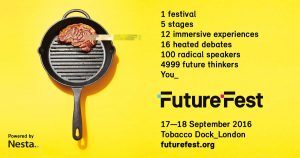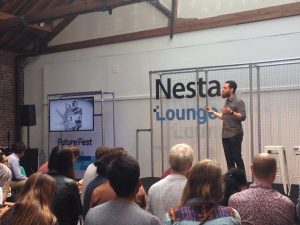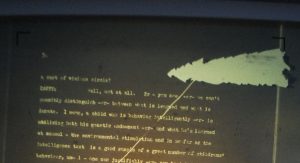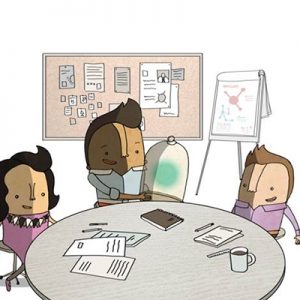#3: The History of the Future of Automation

Hey, I was one of those ‘100 radical speakers’! Or maybe they added an extra slot for me and I was speaker 101. Either way, speaking at FutureFest was a pretty memorable experience.
On both days of the weekend-long festival I spoke about ‘the history of the future of automation’, and both audiences seemed to enjoy themselves. Actually, one of my supervisors put it best when she came over to chat with me after my Saturday talk:
Supervisor: “So how do you think the talk went?”
Me: “Okay, I guess. I forgot to break the seal on my bottle of water before I went on stage so there was a weird pause where I finally had to say to the crowd, ‘Oops, this is an awkward pause.’ And then I think I wore my microphone too high cuz my beard kept rubbing against it which made a weird swishing sound…”
Supervisor: “Stop. If you’re concerned about minutiae after a talk, that’s when you know it went pretty well.”
Me: “Oh… great point!”
Truth be told, I cheated a little bit with the talk. Rather than try to talk for twenty minutes (who wants to listen to that?), I included 5 clips from various films and documentaries from the past century. The clips illustrated points that I was discussing in my talk, but for the most part I included them because I thought they were funny.
— — —
In the run up to the festival I was asked to co-write an article for the Guardian with one of the supervisors of my project. The article argued that as the use of artificial intelligence grows, we will need to find ways to acknowledge and tackle people’s concerns about AI in order to help build public trust in the technology. When I opened the Guardian app on my phone I have to admit I was slightly bemused by the choice of image. HAL 9000 from 2001: A Space Odyssey? Really?! I’ve had a think, and I haven’t been able to come up with a more clichéd image to represent artificial intelligence. One of those skinless Terminators from Terminator 2: Judgment Day might have been a close second. All things considered, though, I guess I should be happy they didn’t go with a screengrab from Johnny Depp’s abysmal AI film, Transcendence. (Disclaimer for Johnny and the Guardian: All in good fun.)
— — —
I am extremely grateful for my time at Nesta and wish them success with their future projects. I’ll miss the free (nasty) coffee, the free fruit on Mondays and Wednesdays, and the free pencils (at least I think they were free). But most of all I’ll miss the people.
Wow, that was cheesy.




